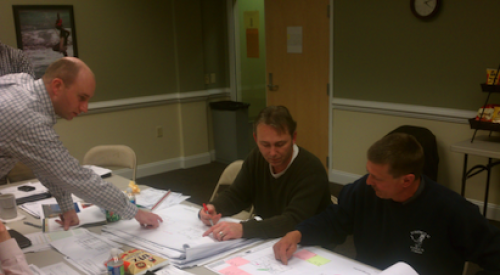Peter Senge wrote one of the best business books of the 1990’s, The Learning Organization. It is one of those on my list to pull off the shelf and read again, if I ever catch up with the stack of unread volumes on my credenza now. I even attended his 4-day workshop in Boston in the mid-90’s and it made a considerable impact on everyone there. What Senge laid out was what constitutes the “Learning Organization” and why those companies invariably do better than those whose primary goal is to replicate and execute their existing business model.
I was thinking about this at the NAHB International Builder’s Show earlier this month, when I ran into Ralph and David Drees from The Drees Companies, clients and long-time friends. Drees has 10 Divisions which, like a David Weekley or a Shea, puts them on that cusp between “large regional” and “national” builders. I had seen a veritable slew of local and smaller regional builders, but Drees was the largest firm I had seen in attendance at IBS. I started paying attention and watching badges.
What I did not see was one single badge from a large national builder. I have been around a long, long time, and doing presentations at a wide variety of industry and company meetings for more than two decades. I know a lot of people and I know many from national builders. You used to see a lot of them at IBS. Not the past few years, though. What I did see was a parade of really strong locals and regionals who operationally put most of the nationals to shame. The nationals, of course, will never believe this. They cannot imagine that a couple of strong locals like 2010 Builder of the Year Jagoe Homes knows something they do not. They cannot conceive that the 2011 recipient of the same award, DSLD, operates more efficiently than they do. Or the eight or ten more builders I could quickly name that schedule, purchase and build better. How could they know? There are not many in our industry who have worked intimately with large numbers of both nationals and locals/regionals. I have and trust me, I am right on this.
Yet, upstairs at IBS, in and around the educational sessions, I saw a steady parade of representatives from the best local and regional builders in the US. And this included many Presidents, CEOs and VP’s. These people are very strong, but what did they spend their time at IBS doing? They were attending the education sessions, challenging themselves and thus their companies with any opportunity to learn more. These are the real “learning organizations.”
I polled about 20 others who attended IBS and only two had seen representatives from national builders, and each of those reported a single occurrence. A good friend of mine from a supplier suggested that perhaps I am miscounting because there are many representatives from nationals that come “incognito,” using badges from suppliers so that they can walk around without being noticed. My friend personally issued 3 of these to one large builder. He also told me that each one was to a senior purchasing representative. So let’s say there were 50 vendors who offered an average of five of these, and I think that is a very high estimate. Take the 40,000 IBS registrants, remove 5,000 vendor participants and 5,000 consultants, spouses, students. That leaves 30,000 and out of those, perhaps there were 250 purchasing managers from national builders there in hiding. That is about a half of a percent. Were there any there from operations? Did any participate in the educational forums? If so, it was precious few.
I know for a fact that the margins of these strong locals and regionals are higher than those of the large nationals. Why is this? I suggest that a huge part of the mystery has to do with who creates, cultivates and maintains their company as a learning organization – and who does not. The learning company is one that can adjust, react, grow and better yet, anticipate market changes. To do that, you have to get out of your company cocoon and challenge your process and methods. That requires you to recognize you just may not be the smartest folks around, even if you are the biggest. And that is a very, very hard thing to do.












